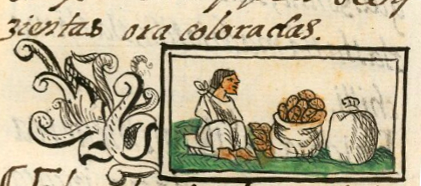cacahuanamacac (FCbk10f46v)
This iconographic example, featuring a cacao seller (cacahuanamacac), is included in this digital collection for the purpose of making comparisons with related hieroglyphs. The term selected for this example comes from the text on the page prior to the one with the image the Digital Florentine Codex. There is no gloss, per se. This example shows a man in a ¾ view, facing toward the viewer’s right, looking at a large sack of cacao (probably pods, as they are too large to be beans). He wears a white shirt and trousers (European-type clothing), plus a Nahua cloak (tilmatli or tilmahtli) tied over his right shoulder. He sits on a low white seat of some kind. Both his clothing and the sack for the cacao are white with shading that gives them a three-dimensionality (showing European artistic influence). The man and the cacao that he is selling are on a ground of green grass (another European artistic tradition). Two woven mats (petlatl) are discernible on this ground, and they were probably meant to be painted yellow.
Stephanie Wood
Nahuatl hieroglyphs of cacao can have a focus on the bean (cacahuatl) itself, or a beautiful cup deservingly full of these precious beans, or a pack full of pods or beans. See below.
Stephanie Wood
Cacaoanamacac
cacahuanamacac
Stephanie Wood
1577
Jeff Haskett-Wood
cocoa, chocolate, beans, bags, sacks, transport, market, granos, bolsas, sacos, trans;porte, mercado, tianguis
cacahuanamacac, the cacao seller, https://nahuatl.wired-humanities.org/content/cacahuanamac
-namacaqui (pl. -namacaque), a suffix referring to an occupation, often a merchant selling something; in the Florentine Codex, often written in the singular as -namacac, https://nahuatl.wired-humanities.org/content/namacaqui
el vendedor de cacao
Stephanie Wood
Available at Digital Florentine Codex/Códice Florentino Digital, edited by Kim N. Richter and Alicia Maria Houtrouw, "Book 10: The People", fol. 46v, Getty Research Institute, 2023. https://florentinecodex.getty.edu/en/book/10/folio/46v/images/0 Accessed 10 September 2025.
Images of the digitized Florentine Codex are made available under the following Creative Commons license: CC BY-NC-ND (Attribution-NonCommercial-NoDerivs 4.0 International). For print-publication quality photos, please contact the Biblioteca Medicea Laurenziana ([email protected]). The Library of Congress has also published this manuscript, using the images of the World Digital Library copy. “The Library of Congress is unaware of any copyright or other restrictions in the World Digital Library Collection. Absent any such restrictions, these materials are free to use and reuse.”





